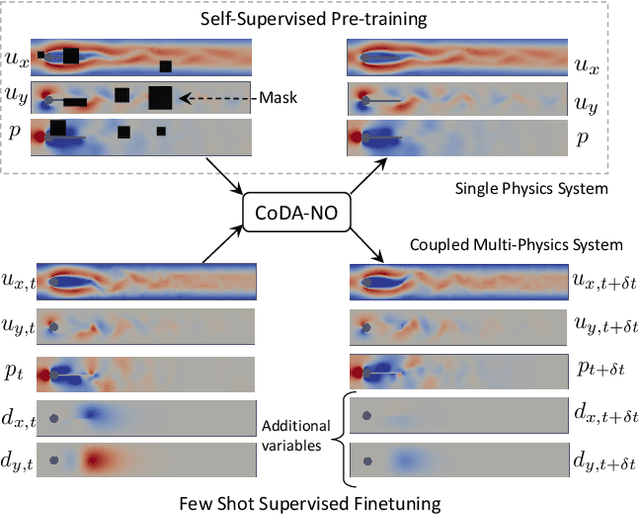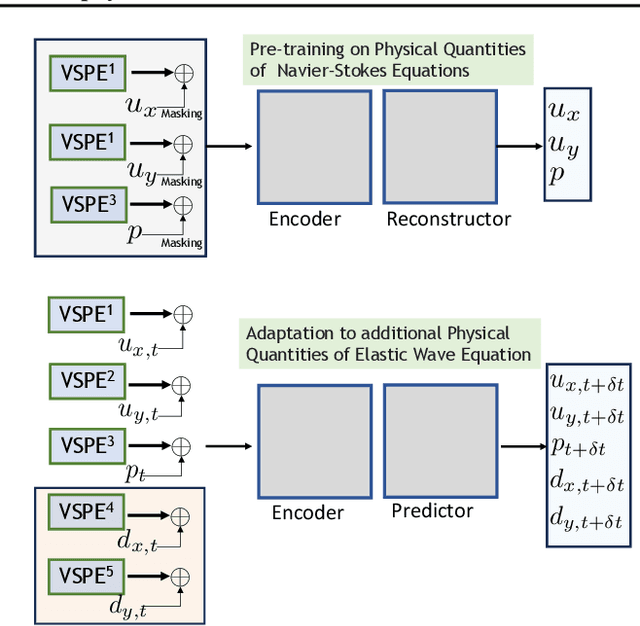Raymond A. Yeh
Multi-Object 3D Grounding with Dynamic Modules and Language-Informed Spatial Attention
Oct 29, 2024Abstract:Multi-object 3D Grounding involves locating 3D boxes based on a given query phrase from a point cloud. It is a challenging and significant task with numerous applications in visual understanding, human-computer interaction, and robotics. To tackle this challenge, we introduce D-LISA, a two-stage approach incorporating three innovations. First, a dynamic vision module that enables a variable and learnable number of box proposals. Second, a dynamic camera positioning that extracts features for each proposal. Third, a language-informed spatial attention module that better reasons over the proposals to output the final prediction. Empirically, experiments show that our method outperforms the state-of-the-art methods on multi-object 3D grounding by 12.8% (absolute) and is competitive in single-object 3D grounding.
Deep Nets with Subsampling Layers Unwittingly Discard Useful Activations at Test-Time
Oct 01, 2024Abstract:Subsampling layers play a crucial role in deep nets by discarding a portion of an activation map to reduce its spatial dimensions. This encourages the deep net to learn higher-level representations. Contrary to this motivation, we hypothesize that the discarded activations are useful and can be incorporated on the fly to improve models' prediction. To validate our hypothesis, we propose a search and aggregate method to find useful activation maps to be used at test time. We applied our approach to the task of image classification and semantic segmentation. Extensive experiments over nine different architectures on multiple datasets show that our method consistently improves model test-time performance, complementing existing test-time augmentation techniques. Our code is available at https://github.com/ca-joe-yang/discard-in-subsampling.
Learning to Obstruct Few-Shot Image Classification over Restricted Classes
Sep 28, 2024Abstract:Advancements in open-source pre-trained backbones make it relatively easy to fine-tune a model for new tasks. However, this lowered entry barrier poses potential risks, e.g., bad actors developing models for harmful applications. A question arises: Is possible to develop a pre-trained model that is difficult to fine-tune for certain downstream tasks? To begin studying this, we focus on few-shot classification (FSC). Specifically, we investigate methods to make FSC more challenging for a set of restricted classes while maintaining the performance of other classes. We propose to meta-learn over the pre-trained backbone in a manner that renders it a ''poor initialization''. Our proposed Learning to Obstruct (LTO) algorithm successfully obstructs four FSC methods across three datasets, including ImageNet and CIFAR100 for image classification, as well as CelebA for attribute classification.
Tree-D Fusion: Simulation-Ready Tree Dataset from Single Images with Diffusion Priors
Jul 14, 2024Abstract:We introduce Tree D-fusion, featuring the first collection of 600,000 environmentally aware, 3D simulation-ready tree models generated through Diffusion priors. Each reconstructed 3D tree model corresponds to an image from Google's Auto Arborist Dataset, comprising street view images and associated genus labels of trees across North America. Our method distills the scores of two tree-adapted diffusion models by utilizing text prompts to specify a tree genus, thus facilitating shape reconstruction. This process involves reconstructing a 3D tree envelope filled with point markers, which are subsequently utilized to estimate the tree's branching structure using the space colonization algorithm conditioned on a specified genus.
Alpha Invariance: On Inverse Scaling Between Distance and Volume Density in Neural Radiance Fields
Apr 02, 2024Abstract:Scale-ambiguity in 3D scene dimensions leads to magnitude-ambiguity of volumetric densities in neural radiance fields, i.e., the densities double when scene size is halved, and vice versa. We call this property alpha invariance. For NeRFs to better maintain alpha invariance, we recommend 1) parameterizing both distance and volume densities in log space, and 2) a discretization-agnostic initialization strategy to guarantee high ray transmittance. We revisit a few popular radiance field models and find that these systems use various heuristics to deal with issues arising from scene scaling. We test their behaviors and show our recipe to be more robust.
Pretraining Codomain Attention Neural Operators for Solving Multiphysics PDEs
Mar 19, 2024



Abstract:Existing neural operator architectures face challenges when solving multiphysics problems with coupled partial differential equations (PDEs), due to complex geometries, interactions between physical variables, and the lack of large amounts of high-resolution training data. To address these issues, we propose Codomain Attention Neural Operator (CoDA-NO), which tokenizes functions along the codomain or channel space, enabling self-supervised learning or pretraining of multiple PDE systems. Specifically, we extend positional encoding, self-attention, and normalization layers to the function space. CoDA-NO can learn representations of different PDE systems with a single model. We evaluate CoDA-NO's potential as a backbone for learning multiphysics PDEs over multiple systems by considering few-shot learning settings. On complex downstream tasks with limited data, such as fluid flow simulations and fluid-structure interactions, we found CoDA-NO to outperform existing methods on the few-shot learning task by over $36\%$. The code is available at https://github.com/ashiq24/CoDA-NO.
AmbiGen: Generating Ambigrams from Pre-trained Diffusion Model
Dec 05, 2023Abstract:Ambigrams are calligraphic designs that have different meanings depending on the viewing orientation. Creating ambigrams is a challenging task even for skilled artists, as it requires maintaining the meaning under two different viewpoints at the same time. In this work, we propose to generate ambigrams by distilling a large-scale vision and language diffusion model, namely DeepFloyd IF, to optimize the letters' outline for legibility in the two viewing orientations. Empirically, we demonstrate that our approach outperforms existing ambigram generation methods. On the 500 most common words in English, our method achieves more than an 11.6% increase in word accuracy and at least a 41.9% reduction in edit distance.
IMMA: Immunizing text-to-image Models against Malicious Adaptation
Nov 30, 2023Abstract:Advancements in text-to-image models and fine-tuning methods have led to the increasing risk of malicious adaptation, i.e., fine-tuning to generate harmful unauthorized content. Recent works, e.g., Glaze or MIST, have developed data-poisoning techniques which protect the data against adaptation methods. In this work, we consider an alternative paradigm for protection. We propose to ``immunize'' the model by learning model parameters that are difficult for the adaptation methods when fine-tuning malicious content; in short IMMA. Empirical results show IMMA's effectiveness against malicious adaptations, including mimicking the artistic style and learning of inappropriate/unauthorized content, over three adaptation methods: LoRA, Textual-Inversion, and DreamBooth.
Truly Scale-Equivariant Deep Nets with Fourier Layers
Nov 06, 2023Abstract:In computer vision, models must be able to adapt to changes in image resolution to effectively carry out tasks such as image segmentation; This is known as scale-equivariance. Recent works have made progress in developing scale-equivariant convolutional neural networks, e.g., through weight-sharing and kernel resizing. However, these networks are not truly scale-equivariant in practice. Specifically, they do not consider anti-aliasing as they formulate the down-scaling operation in the continuous domain. To address this shortcoming, we directly formulate down-scaling in the discrete domain with consideration of anti-aliasing. We then propose a novel architecture based on Fourier layers to achieve truly scale-equivariant deep nets, i.e., absolute zero equivariance-error. Following prior works, we test this model on MNIST-scale and STL-10 datasets. Our proposed model achieves competitive classification performance while maintaining zero equivariance-error.
Making Vision Transformers Truly Shift-Equivariant
May 25, 2023Abstract:For computer vision tasks, Vision Transformers (ViTs) have become one of the go-to deep net architectures. Despite being inspired by Convolutional Neural Networks (CNNs), ViTs remain sensitive to small shifts in the input image. To address this, we introduce novel designs for each of the modules in ViTs, such as tokenization, self-attention, patch merging, and positional encoding. With our proposed modules, we achieve truly shift-equivariant ViTs on four well-established models, namely, Swin, SwinV2, MViTv2, and CvT, both in theory and practice. Empirically, we tested these models on image classification and semantic segmentation, achieving competitive performance across three different datasets while maintaining 100% shift consistency.
 Add to Chrome
Add to Chrome Add to Firefox
Add to Firefox Add to Edge
Add to Edge